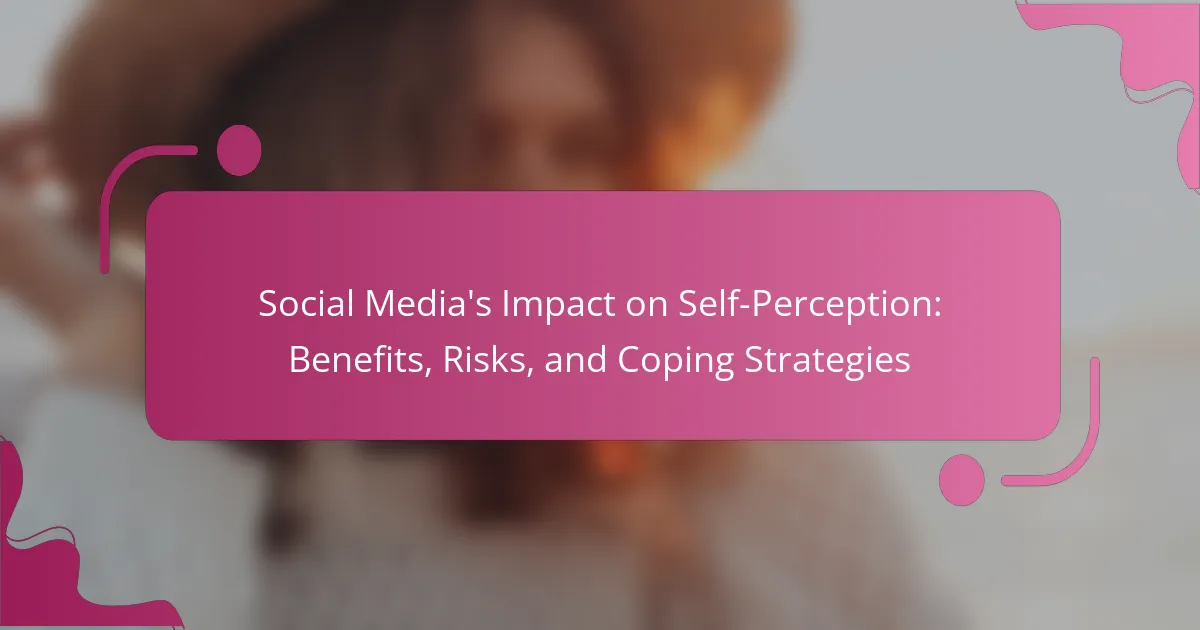Social media significantly shapes self-perception, offering both benefits and risks. It can enhance self-esteem through validation and connection while also fostering negative comparisons and anxiety. Effective coping strategies, such as curating content and setting time limits, are essential for maintaining a balanced self-view. Understanding these dynamics can help individuals navigate their online experiences more positively.
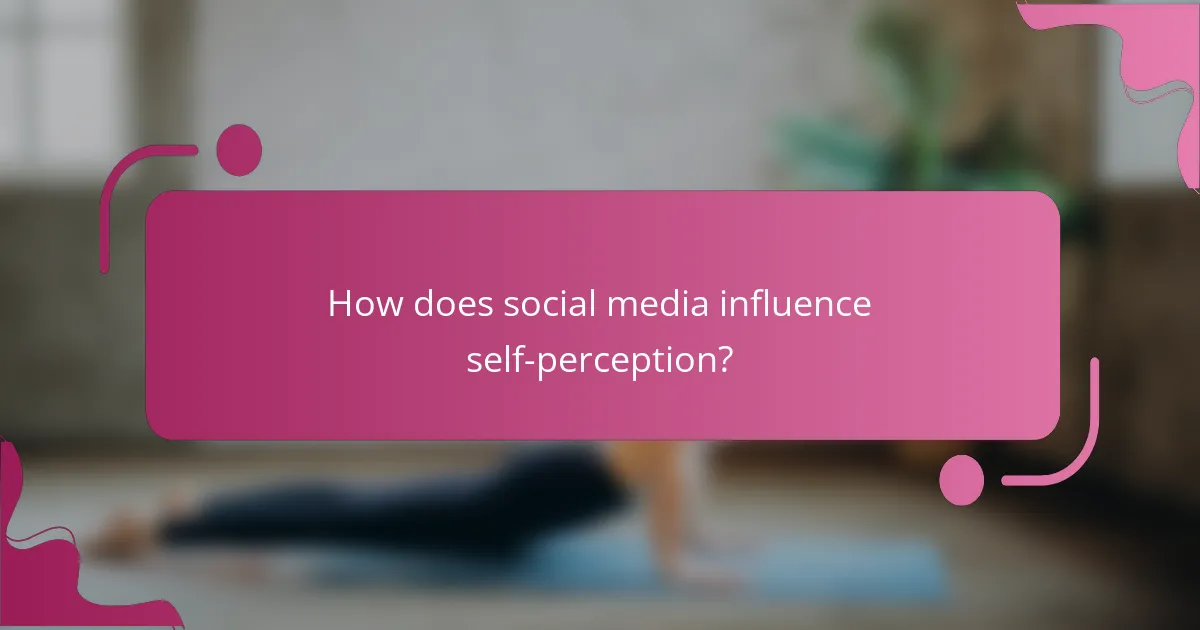
How does social media influence self-perception?
Social media significantly influences self-perception by shaping how individuals view themselves based on online interactions. It can enhance self-esteem through positive feedback but also lead to negative self-image due to comparison with others. Studies indicate that excessive use can increase feelings of inadequacy and anxiety. Coping strategies include curating one’s feed to prioritize uplifting content and engaging in offline activities to foster a balanced self-view.
What psychological mechanisms drive this influence?
Social media influences self-perception through mechanisms like social comparison, validation seeking, and identity exploration. Users often compare themselves to curated online personas, impacting self-esteem. This can lead to negative self-assessment or motivation for self-improvement. Additionally, the desire for likes and comments can create a dependency on external validation, further shaping self-image. Coping strategies include curating feeds, limiting exposure, and engaging in offline activities to foster a healthier self-perception.
Which social media platforms have the most significant impact?
Social media platforms like Instagram, Facebook, and TikTok significantly impact self-perception. These platforms shape users’ views through curated content and social comparisons. Instagram’s visual focus promotes idealized images, often leading to negative self-image. Facebook fosters social validation, which can enhance self-esteem but also contribute to anxiety. TikTok’s rapid content consumption can create unrealistic standards. Understanding these dynamics helps users develop coping strategies to mitigate risks and enhance positive self-perception.
How do different demographics experience these effects?
Different demographics experience social media’s impact on self-perception in varied ways. Younger users often face heightened self-esteem issues due to comparison culture. Older adults may utilize social media for connection, enhancing their self-worth through community engagement.
Research indicates that women frequently report negative body image influenced by idealized representations online. In contrast, men might experience pressure to conform to success and status portrayals.
Coping strategies vary; younger users may seek validation through likes, while older individuals may focus on positive interactions. Understanding these demographic differences can guide tailored approaches to mitigate risks associated with social media use.
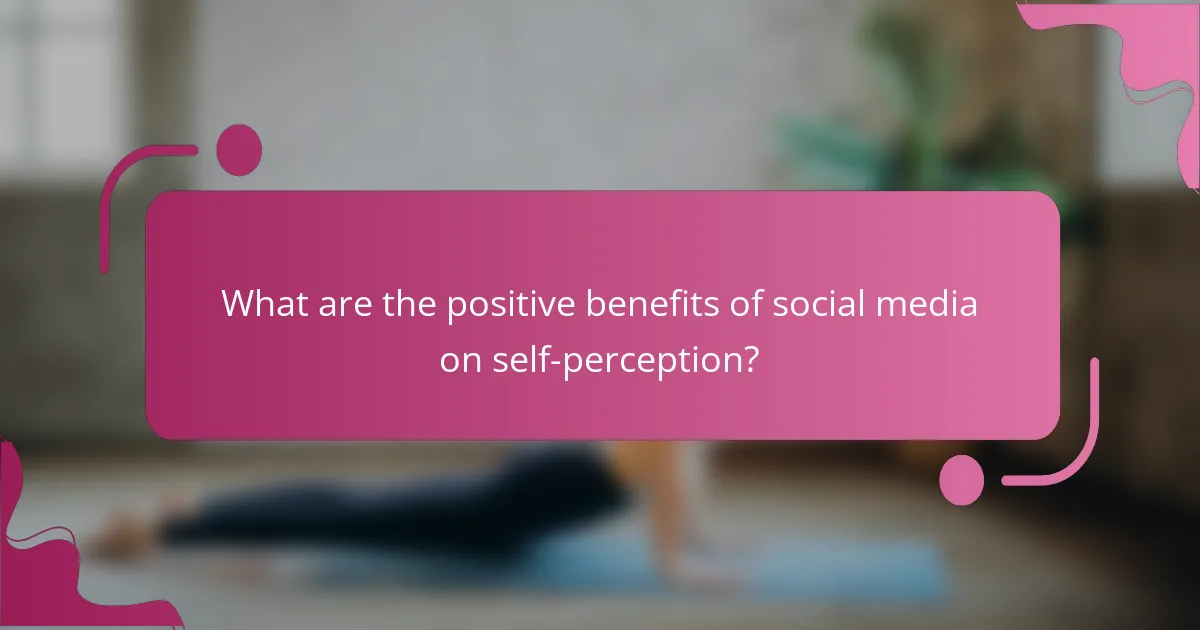
What are the positive benefits of social media on self-perception?
Social media can enhance self-perception by fostering connections, providing validation, and promoting self-expression. Users often experience increased self-esteem through positive interactions and feedback. This platform allows individuals to share achievements, which can boost confidence. Additionally, exposure to diverse perspectives can broaden understanding and acceptance of oneself. However, it is essential to manage potential risks, such as comparison and negativity, to maximize these benefits.
In what ways can social media enhance self-esteem?
Social media can enhance self-esteem by fostering connections, providing positive feedback, and promoting self-expression. These platforms allow individuals to receive encouragement and validation from peers, which can boost confidence. Sharing achievements and personal stories can create a sense of belonging and community. As a result, users may experience improved self-perception and emotional well-being.
How does social connectivity contribute to a positive self-image?
Social connectivity enhances positive self-image by fostering support and validation. Engaging with others on social media can boost self-esteem through affirming interactions. Studies show that users who receive positive feedback report higher self-worth. However, excessive comparison can lead to negative self-perception. Balancing social engagement with self-reflection is essential for maintaining a healthy self-image.
Which communities foster positive self-perception online?
Communities that foster positive self-perception online include supportive social media groups, wellness forums, and body positivity movements. These spaces encourage self-acceptance and provide resources for mental health. Research shows that engagement in such communities can enhance self-esteem and reduce negative self-comparisons. For instance, platforms focused on mental health advocacy promote sharing personal stories, which can create a sense of belonging and validation.
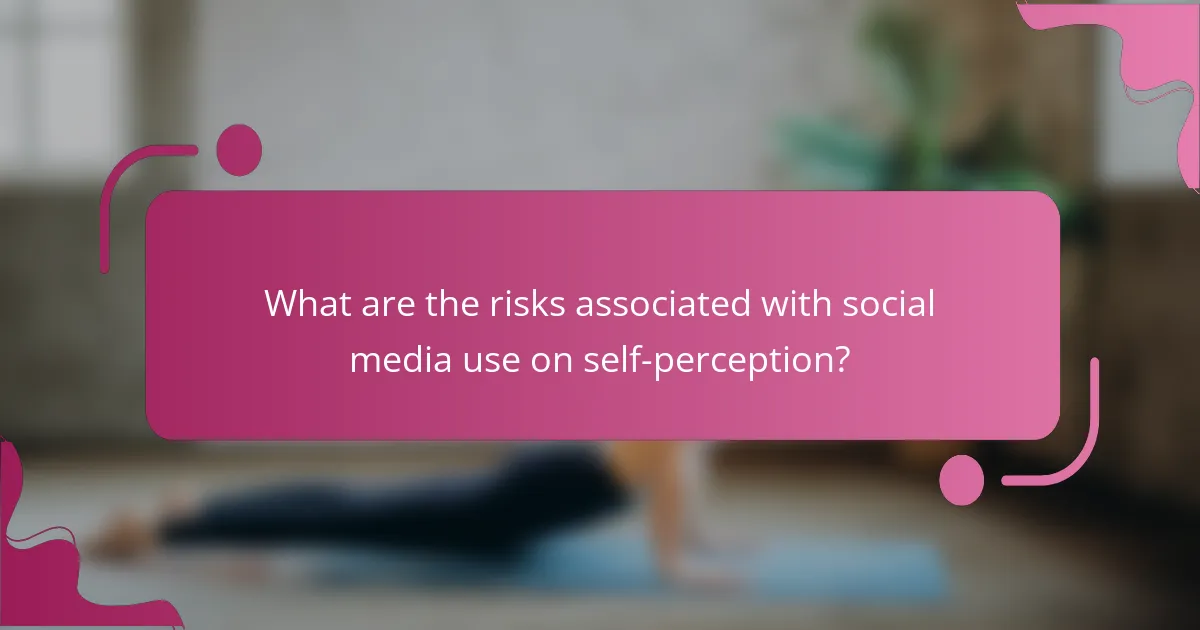
What are the risks associated with social media use on self-perception?
Social media use can negatively affect self-perception through comparison, validation-seeking, and cyberbullying. Users often compare themselves to curated images, leading to feelings of inadequacy. Seeking likes and comments can create dependency on external validation, impacting self-esteem. Cyberbullying can further distort self-image, causing anxiety and depression. Studies indicate that excessive social media use correlates with lower self-esteem and increased body image concerns.
How does comparison culture affect individuals’ self-worth?
Comparison culture negatively impacts individuals’ self-worth by fostering feelings of inadequacy. Social media amplifies this effect through curated content that promotes unrealistic standards. Studies indicate that frequent exposure to idealized images can lead to lower self-esteem and increased anxiety. Coping strategies, such as limiting social media use and practicing self-compassion, can mitigate these effects.
What role does cyberbullying play in self-perception issues?
Cyberbullying significantly harms self-perception by fostering feelings of inadequacy and isolation. Victims often internalize negative comments, which can lead to low self-esteem and anxiety. Research indicates that 20% of adolescents experience cyberbullying, amplifying mental health issues. Social media platforms can perpetuate this cycle, as users compare themselves to curated online personas. Effective coping strategies include promoting digital literacy and fostering supportive online communities.
How can negative feedback impact mental health?
Negative feedback can significantly harm mental health by lowering self-esteem and increasing anxiety. Social media amplifies this effect through constant comparison and validation seeking. Individuals may experience feelings of inadequacy, leading to depression and social withdrawal. Developing coping strategies, such as limiting social media use and fostering positive self-talk, can mitigate these impacts.
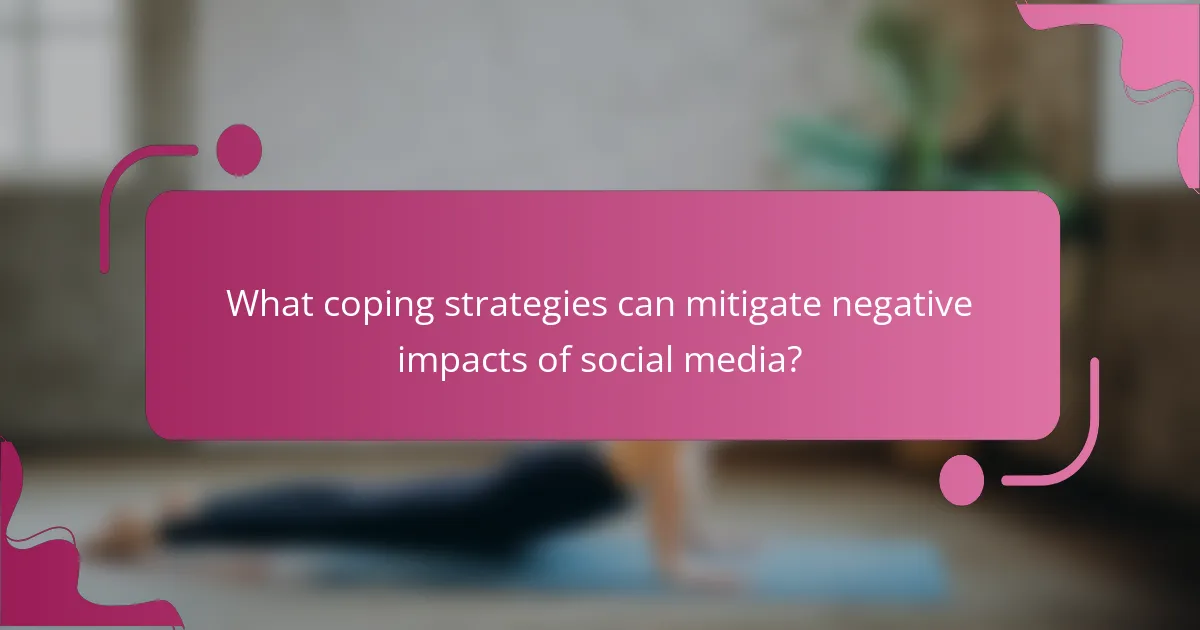
What coping strategies can mitigate negative impacts of social media?
Coping strategies that mitigate negative impacts of social media include setting time limits, curating content, and practicing mindfulness. These approaches help individuals manage exposure and enhance self-perception.
1. Set time limits: Allocate specific times for social media use to prevent overexposure.
2. Curate content: Follow accounts that promote positivity and unfollow those that induce negativity.
3. Practice mindfulness: Engage in activities that foster self-awareness and reduce anxiety related to social media.
4. Seek support: Connect with friends or professionals to discuss feelings about social media experiences.
How can users develop a healthy relationship with social media?
Users can develop a healthy relationship with social media by setting boundaries, curating content, and practicing mindfulness. Establishing time limits helps reduce excessive use, while following accounts that inspire positivity enhances self-perception. Engaging in offline activities fosters balance and improves mental well-being. Regularly reflecting on social media’s impact can also help users identify harmful patterns and adjust their habits accordingly.
What practices promote resilience against negative self-perception?
Practices that promote resilience against negative self-perception include cultivating a positive online environment, engaging in self-reflection, and building supportive relationships. These strategies help mitigate social media’s adverse effects on self-image.
Creating a positive online environment involves curating social media feeds to include uplifting content and unfollowing accounts that trigger negative feelings. Engaging in self-reflection allows individuals to assess their thoughts and feelings critically, fostering a healthier self-image. Building supportive relationships provides emotional reinforcement, countering negative perceptions with positive affirmations.
Additionally, practicing mindfulness and gratitude can enhance overall well-being, further supporting resilience against negative self-perception. These practices empower individuals to navigate social media’s complexities while maintaining a balanced self-view.
How can mindfulness and self-reflection improve social media experiences?
Mindfulness and self-reflection can significantly enhance social media experiences by fostering a healthier self-perception. Practicing mindfulness helps users become aware of their emotional responses to social media, reducing negative impacts. Self-reflection allows individuals to critically assess their online interactions, promoting authenticity and reducing comparison-induced anxiety. These practices can lead to improved mental well-being and a more positive engagement with social media platforms.
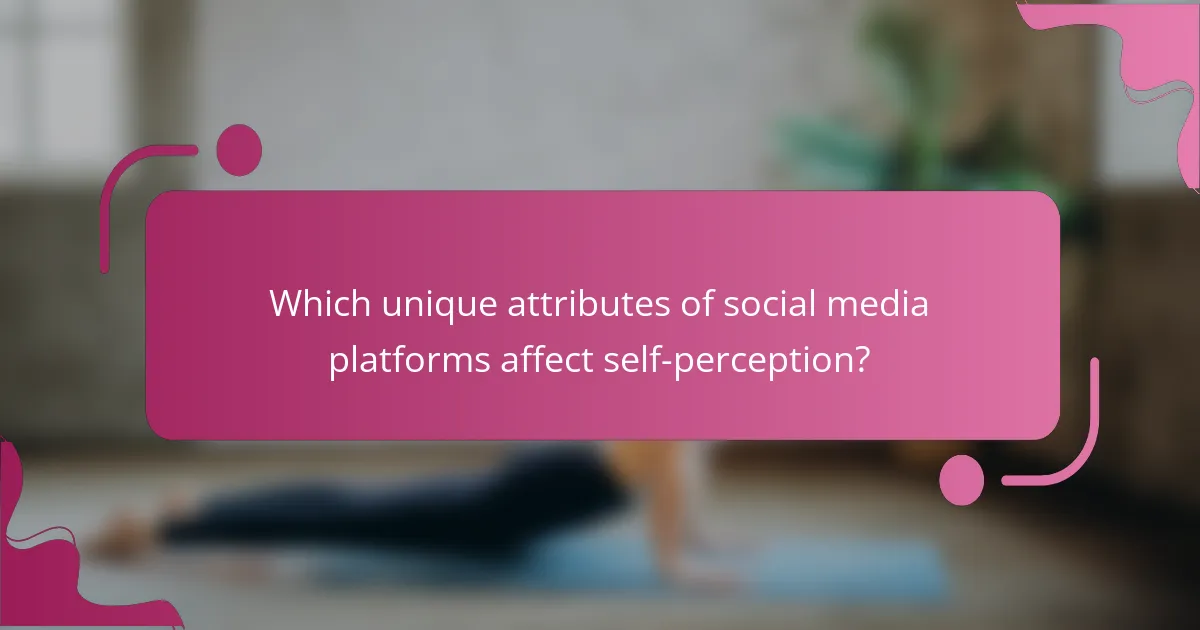
Which unique attributes of social media platforms affect self-perception?
Social media platforms uniquely affect self-perception through curated content, feedback mechanisms, and comparison culture. Curated content allows users to present idealized versions of themselves, leading to unrealistic self-expectations. Feedback mechanisms, such as likes and comments, create validation or criticism, shaping self-esteem. Comparison culture fosters feelings of inadequacy as users compare their lives to others, impacting mental health. These attributes collectively influence how individuals perceive themselves in relation to their online personas.
How do algorithms influence content visibility and self-image?
Algorithms significantly shape content visibility on social media, impacting self-image positively and negatively. They curate personalized experiences, enhancing engagement but also fostering unrealistic comparisons. This dual influence can lead to improved self-esteem for some while exacerbating insecurities for others. Users can cope by diversifying their feeds and critically assessing content.
What features promote engagement and interaction among users?
Features that promote engagement and interaction among users include content personalization, user-generated content, and interactive elements like polls and quizzes. These features enhance user experience and foster community connection. Personalization tailors content to individual preferences, increasing relevance. User-generated content encourages participation and sharing, creating a sense of belonging. Interactive elements invite users to express opinions and engage actively, boosting overall interaction rates.
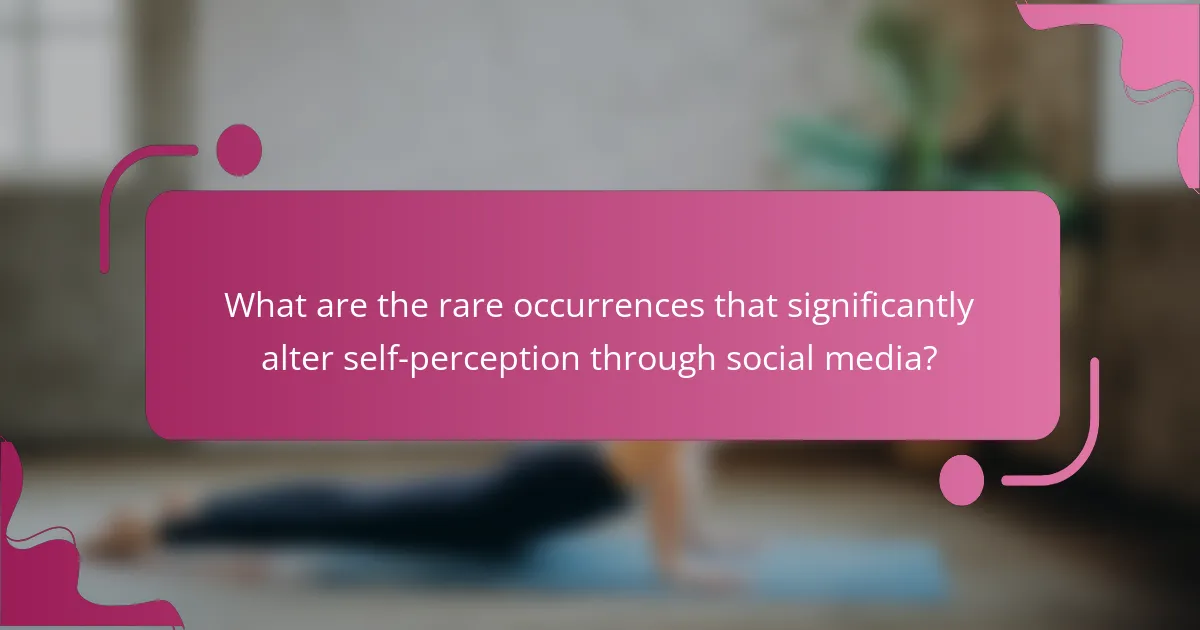
What are the rare occurrences that significantly alter self-perception through social media?
Rare occurrences that significantly alter self-perception through social media include viral trends, negative feedback, and comparison with influencers. These events can lead to a distorted self-image and heightened anxiety. For instance, exposure to unrealistic standards can diminish self-esteem. Additionally, sudden fame from a viral post may create pressure to maintain an idealized persona. Such experiences highlight the need for effective coping strategies to mitigate negative impacts on self-perception.
How do viral trends impact self-image positively or negatively?
Viral trends can impact self-image both positively and negatively. Positive effects include increased self-acceptance and community support, while negative impacts often involve comparison and self-doubt. Social media amplifies these trends, leading to heightened awareness of personal appearance and social validation.
Positive impacts arise when trends promote body positivity or mental health awareness, encouraging individuals to embrace their uniqueness. For instance, viral campaigns celebrating diverse body types can foster a sense of belonging and self-worth.
Conversely, negative effects manifest through unrealistic standards set by influencers. Users may experience anxiety or dissatisfaction with their own lives when comparing themselves to curated online personas. This can lead to a distorted self-image and decreased mental well-being.
Coping strategies include curating social media feeds to follow accounts that promote positivity and self-acceptance. Engaging in offline activities and seeking support from friends can also mitigate negative feelings associated with viral trends.
What are the effects of influencer culture on self-perception?
Influencer culture significantly affects self-perception by shaping ideals and expectations. Social media platforms often showcase curated lifestyles, leading individuals to compare themselves against these standards. This can result in decreased self-esteem and body image issues. Studies indicate that frequent exposure to influencer content correlates with increased feelings of inadequacy and anxiety. To cope, individuals can practice digital detox, engage in self-affirmation, and follow diverse, authentic accounts that promote realistic representations of life.
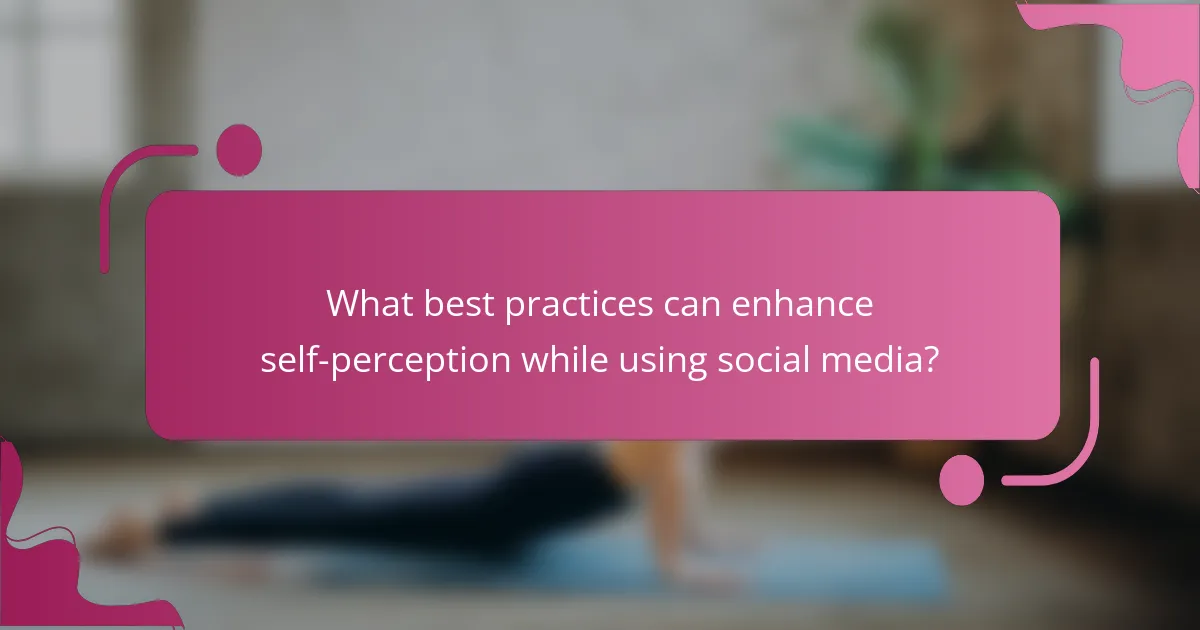
What best practices can enhance self-perception while using social media?
To enhance self-perception while using social media, focus on curating positive content, setting time limits, and engaging with supportive communities. These practices can mitigate risks and promote a healthier self-image.
1. Curate positive content: Follow accounts that inspire and uplift, avoiding negative influences.
2. Set time limits: Reduce exposure to social media to prevent comparison and anxiety.
3. Engage with supportive communities: Participate in groups that foster positivity and encouragement.
4. Practice self-reflection: Regularly assess your feelings about social media interactions to maintain a balanced perspective.
How can users curate their feeds for better mental health?
Users can curate their feeds for better mental health by following specific strategies. First, they should unfollow accounts that promote negativity or unrealistic standards. Second, they can follow accounts that inspire and uplift them, focusing on positivity and authenticity. Third, setting time limits on social media usage can help reduce anxiety and improve overall well-being. Finally, engaging with content that fosters community and support enhances self-perception and emotional resilience. These strategies help mitigate the risks associated with social media while maximizing its benefits.
What steps can be taken to foster a supportive online environment?
To foster a supportive online environment, implement clear guidelines and promote positive interactions. Encourage users to share uplifting content and provide resources for mental health support. Regularly monitor discussions to address negativity and create a culture of respect. Offer training on digital citizenship to enhance empathy and understanding.
